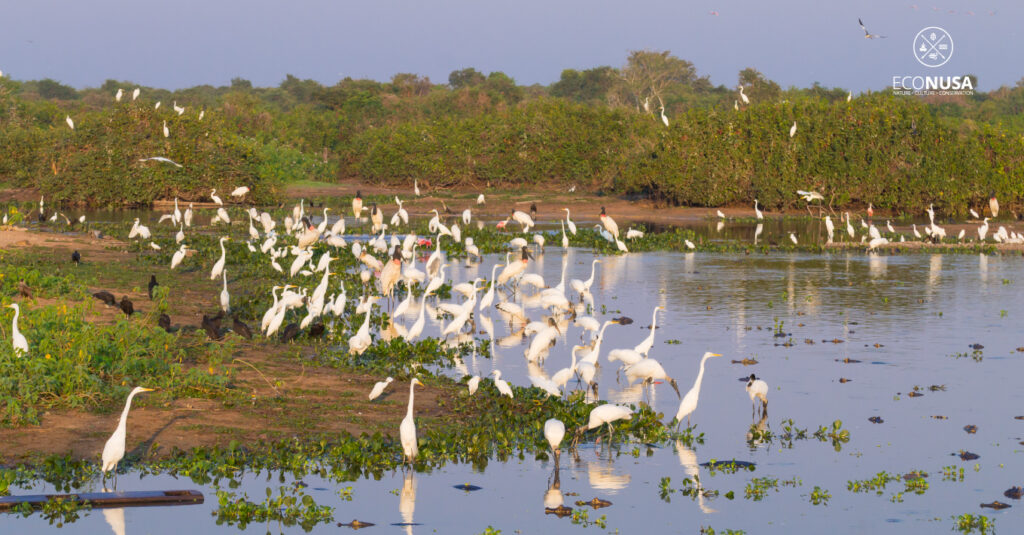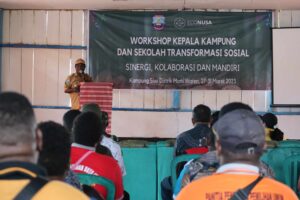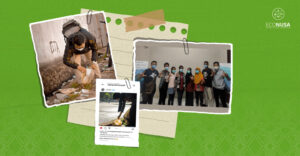
One of the national parks known for its beauty, located in eastern Indonesia is Wasur National Park, Merauke, South Papua Province. When you visit this park, the widest wet savanna forest in Indonesia and Asia will welcome you. The natural beauty of Wasur National Park is what makes it rich in biodiversity.
Approximately 413,810 hectares stretch across three districts, Sota, Naukenjerai, and Merauke Districts are the area of this park. You only need roughly 20 minutes from downtown Merauke. Its close distance and richness of biodiversity have made Wasur Park the perfect place for eco-tourism and research site.
The diversity of flora and fauna found in Wasur National Park ranges from endemic, rare, and protected, to migrant species from neighboring countries. You can find various flora in this Park such as eucalyptus, mangrove type of Bruguiera gymnorrhiza, Avicennia, and Terminalia cattapa. You may also find sago (Metroxylon sago), bamboo, tropical banksia, acacia, golden guinea tree or red beech, pandanus, giant corpse flower, types of ferns, and various types of orchids.
Read also: Forest of Halmahera, A Threatened Enchantment
Wasur National Park is also known as the kingdom of birds. At least 403 species of birds with 74 endemic and 114 protected species live in the area of this park. Migratory birds originating from Australia and New Zealand such as the ibis (Threskiornithinae), magpie goose (Anseranas semipalmata), spoon beak (Calidris pygmaea), kettle (Charadrius leschenaultii), gray heron (Ardea cinerea), and pelicans (Pelecanus conspicillatuas) call this park home. Other bird species that inhabited in this national park include the Irian eagle (Harpyopsis novaeguineae), paradise (Paradisaeidae), cockatoos (Cacatuidae), mambruk (Goura sp), kestrel (Falconidae), bowerbird (Ptilonorhynchidae), grouse (Dendrocygna arcuata), egrets (Ardea sp), etc.
Many bird species depend on Wasur National Park’s wetland ecosystem which is very important for water birds in Indonesia, especially migratory birds to and from Australia and New Zealand. Thus, preserving the area of Wasur National Park is important for the world population as it has become a haven on earth for thousands of migratory birds.

In addition to the wetland area which is used as a “transit point” for migratory birds, Wasur National Park has other areas such as the grassland area, Lake Rawa Biru, Rawa Dogamit, Swamp Mblatar, and Ndalir Beach. Ndalir Beach and Dogamit Swamp are also points visited by migratory shorebirds every year from August to November.
Read also: Bandicoot, The Endemic Marsupial from the Land of Papua
According to Good News From Indonesia (GNFI), the perfect time to observe migratory birds in the Wasur National Park area is in October. During this period of time, birds from the east migrated to the west and transited to Wasur National Park to rest, seeking warmth and breeding. You can observe this species during this time, namely shore sandpipers, black nodding gulls, sunbirds, jambon terns, Australian seabirds, and black-necked terns. In Wasur National Park, bird watching and bird census activities are usually centered around Rawa Biru.
Apart from birds, Wasur National Park has more or less 80 types of mammals, 32 species are endemic to Papua. Approximately 34 of the estimated 72 species of fish also live in this park, with 21 species of reptiles and 3 species of amphibians. Unfortunately, no fixed data have been published for insects.
The importance of protecting the ecosystem in Wasur National Park makes this conservation area one of seven Ramsar sites in Indonesia. Ramsar sites are areas designated for protection in order to maintain the sustainability and function of the world’s wetlands. This designation is the result of the Ramsar Convention, an international agreement for the sustainable use of wetlands. This determination is very beneficial for Indonesia to promote our natural heritage to the world which allows eco-tourism promotion including research potentials.
Read also: Travelling while Preserving Cenderawasih Bird
Communities who live in the buffer zone of Wasur National Park are starting to be aware of these potentials, such as the people of Kuler Village, Naukenjerai District, Merauke. Initially, Wasur National Park Office invited the Kuler Village Government to do a conservation partnership in managing the Ndalir Beach and Dogamit Swamp areas. Both areas are eco-tourism destinations for observing migratory birds which are visited by both domestic and foreign tourists.
Local governments through the National Park Office have conducted outreach to local communities especially in Kuler Village about the importance of preserving Wasur National Park. The communities were involved in protecting its natural beauty and to manage existing resources more effectively and efficiently. Through this collaboration, the economy of Kuler Village people is hoped to be increased and simultaneously protecting and preserving the Park’s rich biodiversity and nature.
Editor: Swinny Adestika




